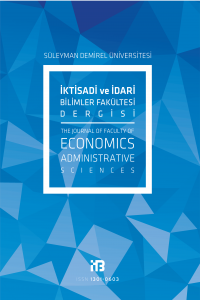YÖNETİM BİLİMİNDE “MODA”: MODERN YÖNETİM TEKNİKLERİNİN YAŞAM DÖNGÜSÜ
1980’lerden sonra yönetim uygulamalarında moda olanın takip edilmesi fikri, akademik çalışmalarda incelenmeye başlanmıştır. Bütün yönetim tekniklerinin ilk başta yönetsel bir moda veya kavramsal anlamda küçük farklılıklarla birlikte heves olarak başladığı, sonrasında ise örgütlerde performans açıklarını kapatmak ya da yöneticilerin uygulamak zorunda hissetmeleri nedeniyle uygulandığı görülmüştür. Bu sürecin böyle algılanmasında ise yöneticilerin, danışmanların ve yönetim gurularının payının olduğu düşünülmektedir. Ancak büyük bir hevesle yaklaşılan ve eski yönetim tekniklerinden izler taşıyan bu yeni moda tekniklerin de zamanla popülaritesini kaybettiği görülmüştür. Çünkü yeni bir moda teknik, eski tekniğin yerini almaya başlamıştır ve bu döngü her seferinde kendini tekrarlamaktadır.
Anahtar Kelimeler:
Yönetim teknikleri, yönetim guruları, moda, heves, yaşam döngüsü
“FASHION” IN SCIENCE OF MANAGEMENT: LIFECYCLE OF MODERN MANAGEMENT TECNIQUES
The idea which follows the fashion in management implementation began to study in academic studies after 1980’s. It was observed that all management techniques initially started as a management fashion or a fad with little conceptual difference. And then this techniques implement to close the performance gaps or managers feel that they have to practice this. It is believed that managers, consultants and gurus have roles about this perception. However this fashion tecniquies which has traces from old techniques lost popularity in time. Because this new fashion tecnique began to replace the old techniques and this loop always repeat itself.
Keywords:
Management tecniques, management gurus, fashion, fad, lifecycle,
___
- ABRAHAMSON, E. (1996), “Management Fashion”, The Academy of Management Review, Vol. 21, No.1, January, pp. 254-285
- ASHKENAS,R. N. ve H. SHAFFERr&ASSOCIATES,R.,(1994), “Beyond the Fads: How Leaders Drive Change with Results”, Human Resource Planning, 17,2, pp. 25-44
- BAMBER,G.,(1999),“Fads, Fashion and Fantasies: Reflections on Management Trends and on University Business School”, A Professorial Lecture, Griffith University
- BENDERS,J., ve Van VEEN, K.,(2001), “ What’s in a Fashion? Interpretative Viability and Management Fashions”, Organization, Volume 8(1), pp: 33-53
- BURGUNDY, J.,(1996), “Shoot the Messenger! Crazy management fads and faddish management “crazies””, Empowerment in Organization, Vol. 4, Issue 4, pp. 28-35
- COLLINS, D.,(2001), “The fad motif in management scholarship”, Employee Relations, Vol.23, Issue 1, pp.26-37
- COLLINS, D. , (2003), "The branding of management knowledge: rethinking management “fads”", Journal of Organizational Change Management, Vol. 16 Issue 2, pp. 186 – 204
- DAVID,R. J. ve STRANG, D.,(2006), “When Fashion is Fleeting: Transitory Collective Beliefs and the Dynamics of TQM Consulting”, Academy of Managemet Journal,Vol. 49, No.2, pp. 215-233
- DONALDSON, L. ve HILMER, F. G. ,(1998), “Management Redeemed: The Case Against Fads that Harm Management”, Organizational Dynamics, pp. 7- 20
- ELMUTI, D. ,(1997), “Self- managed work teams approach: creative management tool or a fad?”, Management Decision, Vol.35, Issue 3, pp. 233-239
- ETTORE, B., (1997), “What’s the Next Business Buzzword”, Management Review, September, 86, 8; ProQuest Central, pp. 33-35
- FERNANDO, M. , (2001), “Are Popular Management Techniques a Waste of Time”, The Academy of Management Executive”, Vol. 15, No.3, pp. 138-140
- GIBSON, J. W. ve TESONE, D.,(2001), “Management Fads: Emergence, Evolutionand Implications for Managers”, The Academy of Management Executive (1993-2005), Vol.15, No.4, November, pp.122-133
- GIBSON, J. W. ,TESONE, D. ve BLACKWELL, C. W.,(2003), “Management Fads: Here Yesterday, Gone Today?”, Advanced Management Journal, Autumn, 68,4, pp.12-17
- HIRSC, P. M. ,(1972), “Processing fads and fashions: An Organization Set of Cultural Industry Systems, American Journal of Sociology, Vol. 77, No. 4, pp. 639-659
- HISLOP, D. ,(2010), “Knowledge management as an ephemeral management fashion”, Journal of Knowledge Management, Vol. 14, No 6, pp. 779-790
- LANG, G. ve OHANA, M. , (2012), “ Are Management Fashions Dangerous for Organizations?”, International Journal of Business and Management, Vol.7, No.20, pp.81-89
- MACDONALDS, S. ve KAM, J. ,(2009), “Publishing in top journals- a never ending fad?”, Scandinavian Journal of Management, 25 (2), pp. 221-224
- MATHEWS, P. ,(2015), “Deconstruction management fad adoption: towards a conceptual model”, International Journal of Organizational Analysis, Vol. 23, No. 2, pp. 302-319
- MILLER, D. ve HARTWICK, J. ,(2002), “Spotting Management Fads”, Harward Business Review, pp. 26-27
- NEWELL, S. , ROBERTSON, M. ve SWAN, J. , (2001)“Management Fads and Fashions”, Organization, Volume 8(1), pp. 5-15
- ÖZEN, Ş. , (1999), "Türkiye'deki Guru Söylemi Modasının Nedenleri " Ankara Üniversitesi SBF Dergisi, 54.01, s.97-121
- PANZI, L. J. ve KOENIG, M. ,(2002) “Knowledge management; another management fad?”, Information Research, 8.1 ;8-1
- PARKER, L. D. ve RITSON, P. ,(2005) “Fads, stereotypes and management gurus: Fayol and Follett today”, Management Decision, 43, 10, pp. 1335-1355 RIKKERS, L. F. (2002), “TheBandwagon effect”, Journal of Gastrointestinal Surgery, 6.6, pp.787- 794
- SCHMITT-BECK, R. (2008), “Badwagon effect”, The International Encyclopedia of Political Communication
- SPELL, C. , (1999), “Where do management fashions come from, and how long do they stay?”, Journal of Management History, Vol. 5, Issue 6, pp. 334-348
- TOWILL, D.,R., (2006), “Fadatomy- anatomy of the transformation of a fad into a management paradigm”, Journal of Management History, Vol. 12, Issue 3, pp. 319-338
- TÖREMEN, F. , (2000), "Kaos teorisi ve eğitim yöneticisinin rolü."Kuram ve Uygulamada Eğitim Yönetimi Dergisi, 6.2., s. 203-219.
- ISSN: 1301-0603
- Yayın Aralığı: Yılda 3 Sayı
- Başlangıç: 1996
- Yayıncı: Süleyman Demirel Üniversitesi
Sayıdaki Diğer Makaleler
YÖNETİM BİLİMİNDE “MODA”: MODERN YÖNETİM TEKNİKLERİNİN YAŞAM DÖNGÜSÜ
Cansu TOR KADIOĞLU, Ayşe ŞAHİN
GELİŞMİŞ-GELİŞMEKTE OLAN ÜLKELERDE NÜFUS ARTIŞI VE SÜRDÜRÜLEBİLİR KALKINMA: BİR IV(2SLS) YAKLAŞIMI
Naif Fıratcan ÇINAR, Alper TÜTÜNSATAR
DESTİNASYON SLOGANLARINDA KULLANILAN TEMALARIN ANALİZİ
Sine ERDOĞAN MORÇİN, Didar BUYUKER İŞLER
KURUMSAL KAYNAK PLANLAMASI (ERP) YAZILIMININ EN UYGUN UZLAŞIK ÇÖZÜM (VIKOR) İLE SEÇİMİ
Remzi BAŞAR, Hakan Murat ARSLAN
MARKAYA DUYULAN GÜVEN VE ETNOSENTRİK EĞİLİMLERİN MARKA SADAKATİNE ETKİSİ: BİR MARKA ÖRNEĞİ
